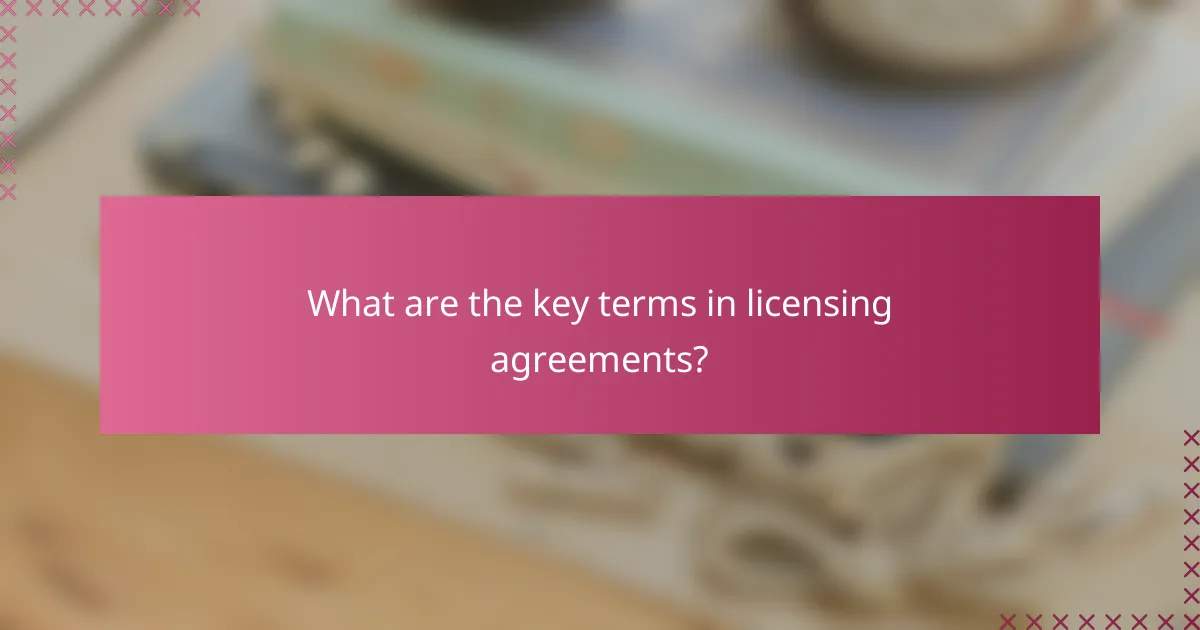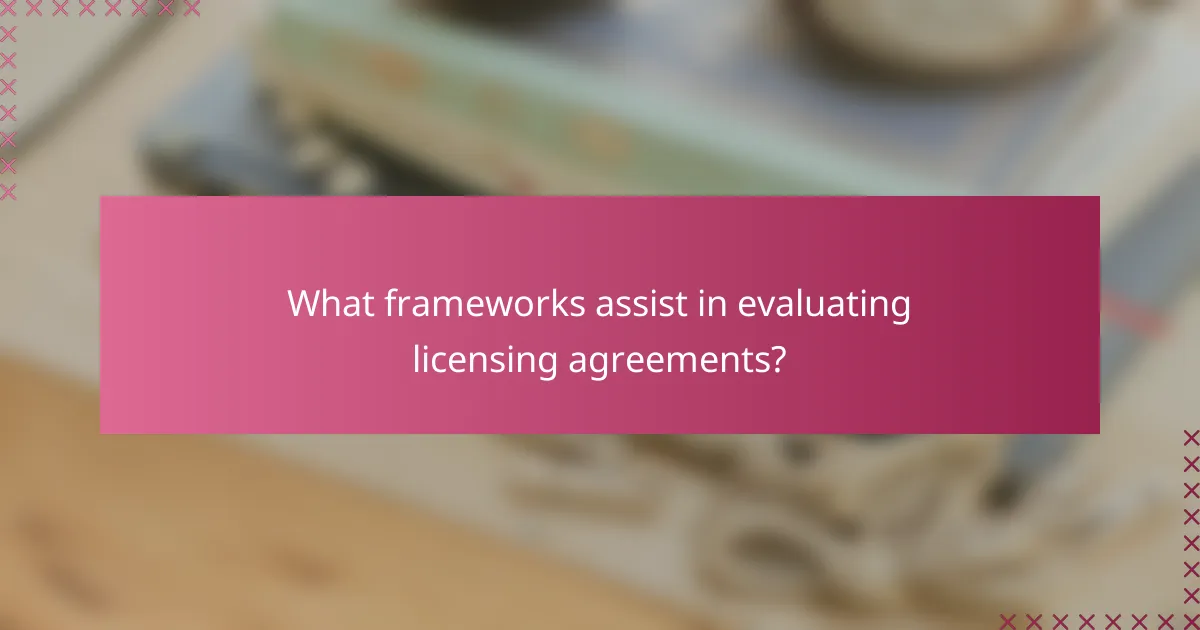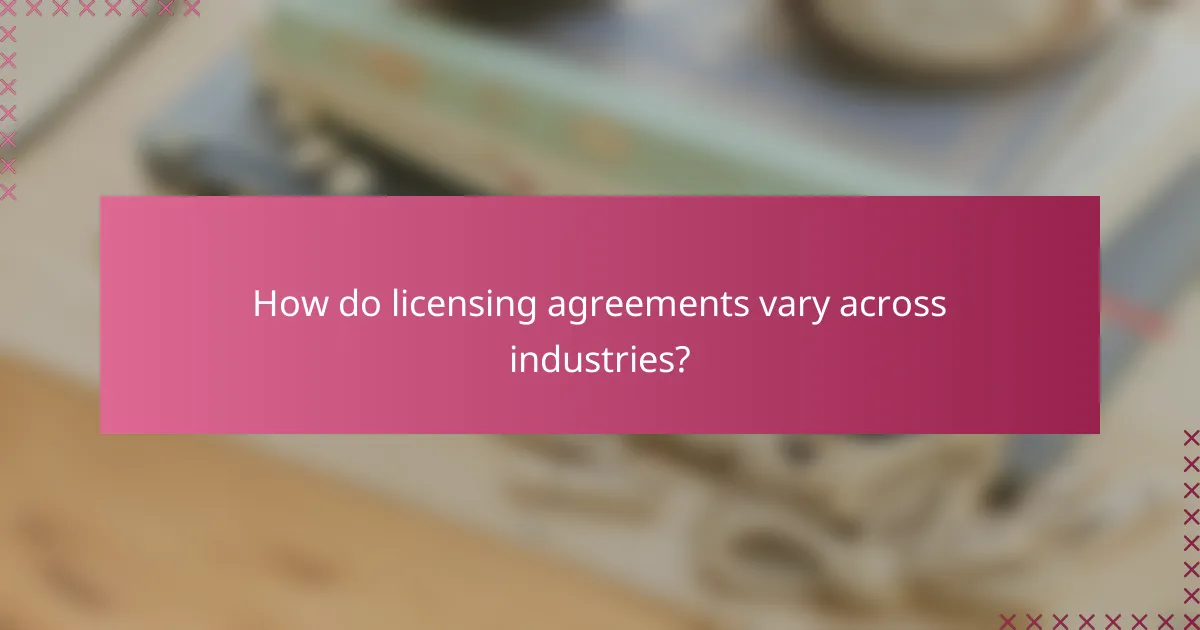Licensing agreements are essential legal documents that outline the rights and obligations of the parties involved, making it vital to understand their key terms for successful negotiation and compliance. Effective negotiation requires careful preparation and a clear understanding of both parties’ needs to create a mutually beneficial agreement. Additionally, addressing common compliance issues, such as royalty obligations and intellectual property infringement, is crucial for maintaining legal standing and ensuring the success of the arrangement.

What are the key terms in licensing agreements?
Licensing agreements typically include several key terms that define the rights and responsibilities of the parties involved. Understanding these terms is crucial for effective negotiation and compliance.
Intellectual property rights
Intellectual property rights (IPR) are the foundation of licensing agreements, determining who owns the rights to the licensed material. These rights can include patents, trademarks, copyrights, and trade secrets. It’s essential to clearly specify which rights are being licensed and any limitations on their use.
For example, a software licensing agreement may grant the licensee the right to use the software but not to modify or distribute it. Clearly delineating these rights helps prevent disputes and ensures both parties understand their obligations.
Royalty structures
Royalty structures outline how payments will be made from the licensee to the licensor for the use of the intellectual property. Common structures include fixed fees, percentage-based royalties, or milestone payments. The choice of structure can significantly impact the financial viability of the agreement for both parties.
For instance, a percentage-based royalty might be more favorable for a licensor if the product is expected to generate high sales, while a fixed fee might be preferable for a licensee looking to manage costs. Negotiating these terms requires careful consideration of projected revenues and market conditions.
Termination clauses
Termination clauses specify the conditions under which either party can end the licensing agreement. These clauses are critical for protecting both parties’ interests and should outline the notice period and any obligations upon termination. Common reasons for termination include breach of contract, insolvency, or failure to meet performance metrics.
For example, a termination clause might allow a licensor to terminate the agreement if the licensee fails to pay royalties for a specified period. Clearly defined termination conditions help mitigate risks and provide a clear exit strategy if needed.
Exclusivity provisions
Exclusivity provisions determine whether the licensee has exclusive rights to use the licensed material within a certain market or territory. An exclusive license can provide significant competitive advantages but may come with higher costs or stricter obligations. Non-exclusive licenses, on the other hand, allow multiple licensees to use the same rights.
For example, a licensor may grant an exclusive license to a manufacturer in a specific region, preventing others from using the same rights in that area. Understanding the implications of exclusivity is vital for both parties when negotiating terms.
Territorial restrictions
Territorial restrictions define the geographical areas where the licensee can operate under the agreement. These restrictions can be crucial for protecting market interests and ensuring compliance with local laws. It’s important to clearly outline these territories to avoid conflicts and ensure that both parties understand their rights.
For instance, a licensing agreement might allow a company to sell a product only in Europe, while another company holds the rights for North America. Clearly defined territorial boundaries help prevent overlapping rights and potential legal disputes.

How to negotiate licensing agreements effectively?
Effective negotiation of licensing agreements involves thorough preparation, clear objectives, and an understanding of both parties’ needs. By following structured steps, you can create a mutually beneficial agreement that meets your goals while respecting the interests of the other party.
Preparation and research
Before entering negotiations, conduct comprehensive research on the market, industry standards, and the specific terms relevant to your licensing agreement. Familiarize yourself with similar agreements to understand common practices and potential pitfalls.
Gather information about the other party, including their business model, past agreements, and negotiation style. This knowledge will help you anticipate their needs and objections, allowing for a more strategic approach during discussions.
Setting clear objectives
Establish clear objectives for what you want to achieve from the licensing agreement. Define your priorities, such as financial terms, duration, and scope of use. Knowing your non-negotiables will help you stay focused during negotiations.
Consider creating a ranking system for your objectives, categorizing them into must-haves and nice-to-haves. This will allow you to make informed trade-offs if necessary, ensuring you secure the most critical aspects of the agreement.
Understanding the other party’s needs
To negotiate effectively, it’s crucial to understand the other party’s needs and motivations. Engage in active listening to identify their priorities and concerns, which can provide valuable insights into their negotiation strategy.
By acknowledging their needs, you can propose solutions that address both parties’ interests. This collaborative approach can foster goodwill and lead to a more favorable outcome for everyone involved.
Utilizing legal counsel
Involving legal counsel in the negotiation process is essential for ensuring that the agreement complies with relevant laws and regulations. A lawyer can help you identify potential legal issues and protect your interests throughout the negotiation.
Consider having legal counsel review the final agreement before signing. This can help prevent misunderstandings and disputes down the line, ensuring that all terms are clear and enforceable.

What are common compliance issues in licensing agreements?
Common compliance issues in licensing agreements include failure to meet royalty obligations, infringement of intellectual property, and non-compliance with territorial restrictions. Addressing these issues is crucial for maintaining legal standing and ensuring the success of the licensing arrangement.
Failure to meet royalty obligations
Failure to meet royalty obligations occurs when a licensee does not pay the agreed-upon royalties on time or in full. This can lead to financial disputes and potential termination of the licensing agreement. Licensees should track sales accurately and ensure timely payments to avoid penalties.
To prevent issues, establish clear payment schedules and methods in the agreement. Regular audits can help verify compliance and ensure that both parties adhere to the financial terms.
Infringement of intellectual property
Infringement of intellectual property happens when a licensee uses the licensed material beyond the agreed terms or without proper authorization. This can result in legal action from the licensor, leading to costly litigation and damage to reputation. Licensees must understand the scope of their rights and limitations under the agreement.
To mitigate risks, include specific clauses that define permissible uses and outline consequences for infringement. Regular training on intellectual property rights can also help licensees stay compliant.
Non-compliance with territorial restrictions
Non-compliance with territorial restrictions refers to a licensee operating outside the geographical limits defined in the licensing agreement. This can lead to market saturation, brand dilution, and conflicts with other licensees. It is essential for licensees to respect these boundaries to maintain the integrity of the brand and the agreement.
To ensure compliance, clearly outline territorial rights in the contract and monitor activities in those regions. Consider implementing a reporting system for licensees to confirm their adherence to territorial limitations.

What frameworks assist in evaluating licensing agreements?
Several frameworks can effectively assist in evaluating licensing agreements, including risk assessment matrices and cost-benefit analysis. These tools help stakeholders identify potential risks and weigh the financial implications of entering into a licensing deal.
Risk assessment matrices
Risk assessment matrices provide a visual representation of potential risks associated with a licensing agreement. By categorizing risks based on their likelihood and impact, stakeholders can prioritize which risks require mitigation strategies. For example, a matrix might classify risks into low, medium, and high categories, allowing for focused attention on the most critical issues.
When using a risk assessment matrix, consider factors such as market volatility, compliance requirements, and intellectual property protection. A common pitfall is underestimating the likelihood of certain risks, which can lead to inadequate preparation and unexpected challenges.
Cost-benefit analysis
Cost-benefit analysis evaluates the financial implications of a licensing agreement by comparing the expected benefits against the associated costs. This analysis helps determine whether the potential revenue from licensing outweighs expenses such as royalties, legal fees, and operational costs. A straightforward approach is to list all expected revenues and costs, then calculate the net benefit.
When conducting a cost-benefit analysis, consider both direct and indirect costs, including potential market share gains or losses. It’s essential to remain realistic about revenue projections; overly optimistic estimates can skew the analysis and lead to poor decision-making. A practical tip is to perform sensitivity analysis to understand how changes in key assumptions affect the overall outcome.

How do licensing agreements vary across industries?
Licensing agreements differ significantly across industries based on the nature of the products or services involved, the regulatory environment, and the specific business models. Each industry has unique considerations that shape the terms, negotiation strategies, and compliance requirements of these agreements.
Technology licensing
Technology licensing involves the transfer of rights to use, modify, or sell technology products or services. Companies often negotiate terms that cover intellectual property rights, royalties, and the duration of the license. Common examples include software licenses, patents, and proprietary technology agreements.
When negotiating technology licenses, parties should consider factors such as exclusivity, territory, and support obligations. It is crucial to clearly define the scope of use to avoid potential disputes. For instance, a software company might license its product for use in specific industries or geographical areas.
Franchise agreements
Franchise agreements allow one party to operate a business under the branding and operational model of another. These agreements typically include terms related to fees, training, marketing support, and operational guidelines. Franchisors often require franchisees to adhere to strict standards to maintain brand consistency.
Key considerations in franchise agreements include the initial franchise fee, ongoing royalties, and the duration of the agreement. Franchisees should carefully review the Franchise Disclosure Document (FDD) to understand their rights and obligations. For example, a fast-food franchise may require specific equipment and supply sources to ensure uniformity across locations.
Publishing contracts
Publishing contracts govern the rights and responsibilities between authors and publishers regarding the distribution of written works. These agreements typically outline royalties, rights to adaptations, and the duration of the publishing rights. Authors must negotiate terms that protect their intellectual property while ensuring fair compensation.
When entering a publishing contract, authors should focus on the royalty structure, rights reversion clauses, and the scope of distribution. For instance, an author might negotiate a higher royalty rate for digital sales compared to print. Understanding these elements can help authors secure favorable terms that align with their career goals.
